tow Hyundai Accent 2008 Owner's Manual
[x] Cancel search | Manufacturer: HYUNDAI, Model Year: 2008, Model line: Accent, Model: Hyundai Accent 2008Pages: 273, PDF Size: 9.36 MB
Page 15 of 273
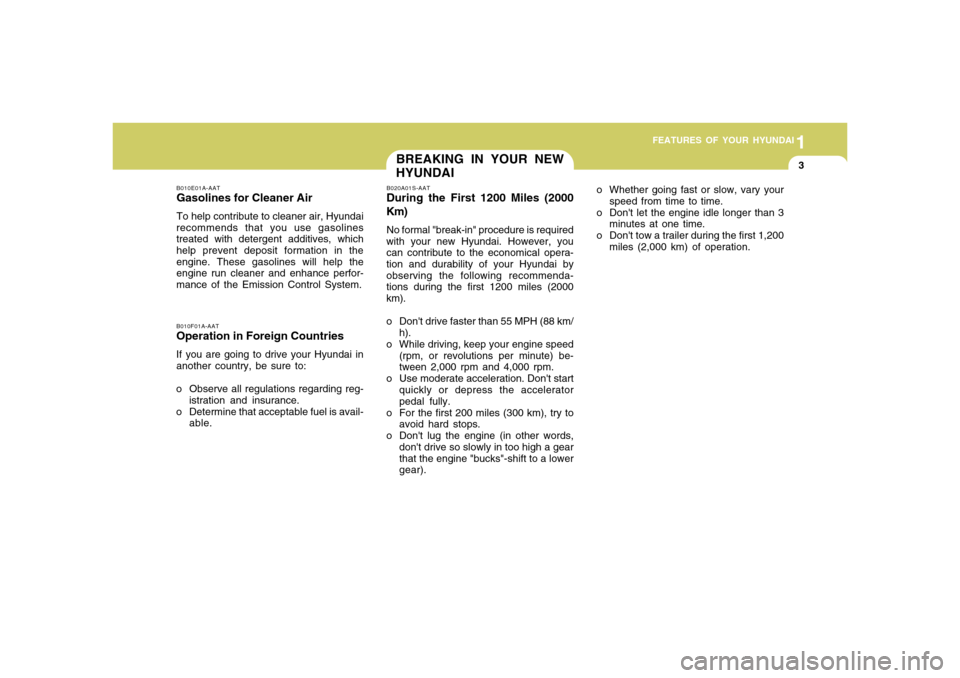
1
FEATURES OF YOUR HYUNDAI
31
FEATURES OF YOUR HYUNDAI
3
BREAKING IN YOUR NEW
HYUNDAI
B010F01A-AATOperation in Foreign CountriesIf you are going to drive your Hyundai in
another country, be sure to:
o Observe all regulations regarding reg-
istration and insurance.
o Determine that acceptable fuel is avail-
able.B010E01A-AATGasolines for Cleaner AirTo help contribute to cleaner air, Hyundai
recommends that you use gasolines
treated with detergent additives, which
help prevent deposit formation in the
engine. These gasolines will help the
engine run cleaner and enhance perfor-
mance of the Emission Control System.
B020A01S-AATDuring the First 1200 Miles (2000
Km)No formal "break-in" procedure is required
with your new Hyundai. However, you
can contribute to the economical opera-
tion and durability of your Hyundai by
observing the following recommenda-
tions during the first 1200 miles (2000
km).
o Don't drive faster than 55 MPH (88 km/
h).
o While driving, keep your engine speed
(rpm, or revolutions per minute) be-
tween 2,000 rpm and 4,000 rpm.
o Use moderate acceleration. Don't start
quickly or depress the accelerator
pedal fully.
o For the first 200 miles (300 km), try to
avoid hard stops.
o Don't lug the engine (in other words,
don't drive so slowly in too high a gear
that the engine "bucks"-shift to a lower
gear).o Whether going fast or slow, vary your
speed from time to time.
o Don't let the engine idle longer than 3
minutes at one time.
o Don't tow a trailer during the first 1,200
miles (2,000 km) of operation.
Page 17 of 273
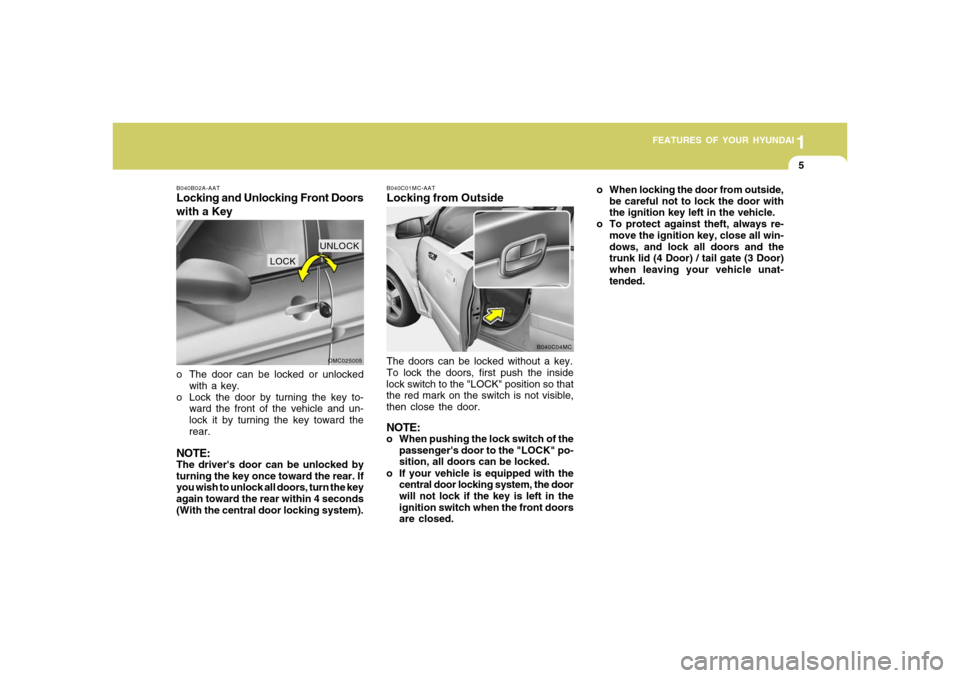
1
FEATURES OF YOUR HYUNDAI
51
FEATURES OF YOUR HYUNDAI
5
B040B02A-AATLocking and Unlocking Front Doors
with a Keyo The door can be locked or unlocked
with a key.
o Lock the door by turning the key to-
ward the front of the vehicle and un-
lock it by turning the key toward the
rear.NOTE:The driver's door can be unlocked by
turning the key once toward the rear. If
you wish to unlock all doors, turn the key
again toward the rear within 4 seconds
(With the central door locking system).
OMC025005UNLOCK
LOCK
The doors can be locked without a key.
To lock the doors, first push the inside
lock switch to the "LOCK" position so that
the red mark on the switch is not visible,
then close the door.NOTE:o When pushing the lock switch of the
passenger's door to the "LOCK" po-
sition, all doors can be locked.
o If your vehicle is equipped with the
central door locking system, the door
will not lock if the key is left in the
ignition switch when the front doors
are closed.B040C01MC-AATLocking from Outside
B040C04MC
o When locking the door from outside,
be careful not to lock the door with
the ignition key left in the vehicle.
o To protect against theft, always re-
move the ignition key, close all win-
dows, and lock all doors and the
trunk lid (4 Door) / tail gate (3 Door)
when leaving your vehicle unat-
tended.
Page 19 of 273
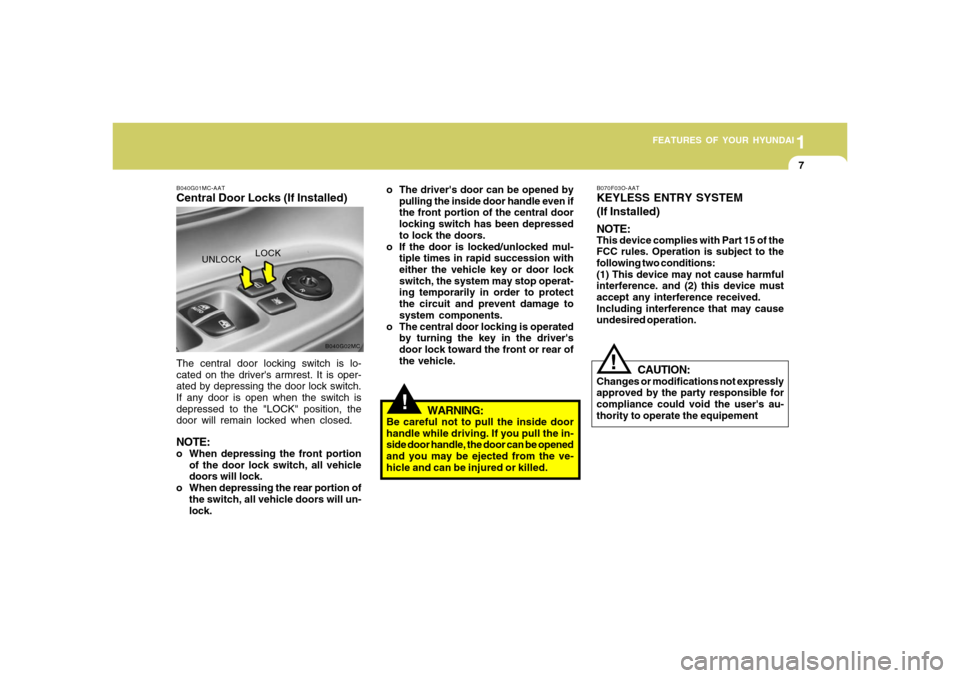
1
FEATURES OF YOUR HYUNDAI
71
FEATURES OF YOUR HYUNDAI
7
!
B040G01MC-AATCentral Door Locks (If Installed)The central door locking switch is lo-
cated on the driver's armrest. It is oper-
ated by depressing the door lock switch.
If any door is open when the switch is
depressed to the "LOCK" position, the
door will remain locked when closed.NOTE:o When depressing the front portion
of the door lock switch, all vehicle
doors will lock.
o When depressing the rear portion of
the switch, all vehicle doors will un-
lock.
B040G02MC
o The driver's door can be opened by
pulling the inside door handle even if
the front portion of the central door
locking switch has been depressed
to lock the doors.
o If the door is locked/unlocked mul-
tiple times in rapid succession with
either the vehicle key or door lock
switch, the system may stop operat-
ing temporarily in order to protect
the circuit and prevent damage to
system components.
o The central door locking is operated
by turning the key in the driver's
door lock toward the front or rear of
the vehicle.
WARNING:
Be careful not to pull the inside door
handle while driving. If you pull the in-
side door handle, the door can be opened
and you may be ejected from the ve-
hicle and can be injured or killed.
!
B070F03O-AATKEYLESS ENTRY SYSTEM
(If Installed)
NOTE:This device complies with Part 15 of the
FCC rules. Operation is subject to the
following two conditions:
(1) This device may not cause harmful
interference. and (2) this device must
accept any interference received.
Including interference that may cause
undesired operation.
CAUTION:
Changes or modifications not expressly
approved by the party responsible for
compliance could void the user's au-
thority to operate the equipement
UNLOCKLOCK
Page 26 of 273
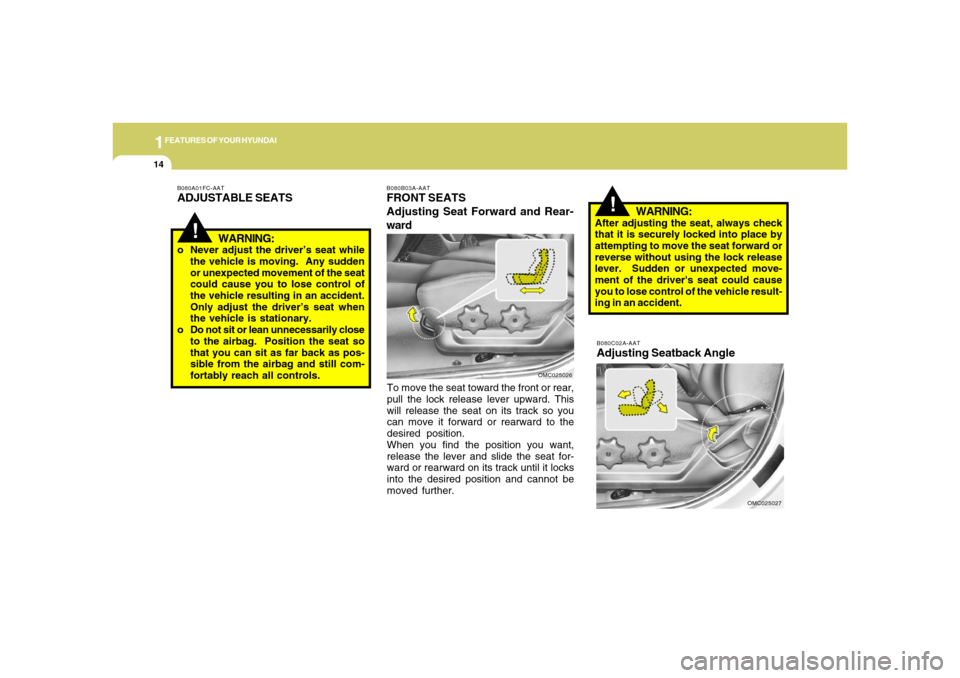
1FEATURES OF YOUR HYUNDAI14
B080C02A-AATAdjusting Seatback Angle
OMC025027
To move the seat toward the front or rear,
pull the lock release lever upward. This
will release the seat on its track so you
can move it forward or rearward to the
desired position.
When you find the position you want,
release the lever and slide the seat for-
ward or rearward on its track until it locks
into the desired position and cannot be
moved further.
OMC025026
!
WARNING:
After adjusting the seat, always check
that it is securely locked into place by
attempting to move the seat forward or
reverse without using the lock release
lever. Sudden or unexpected move-
ment of the driver's seat could cause
you to lose control of the vehicle result-
ing in an accident.
B080B03A-AATFRONT SEATS
Adjusting Seat Forward and Rear-
ward
!
WARNING:
o Never adjust the driver’s seat while
the vehicle is moving. Any sudden
or unexpected movement of the seat
could cause you to lose control of
the vehicle resulting in an accident.
Only adjust the driver’s seat when
the vehicle is stationary.
o Do not sit or lean unnecessarily close
to the airbag. Position the seat so
that you can sit as far back as pos-
sible from the airbag and still com-
fortably reach all controls.B080A01FC-AATADJUSTABLE SEATS
Page 31 of 273
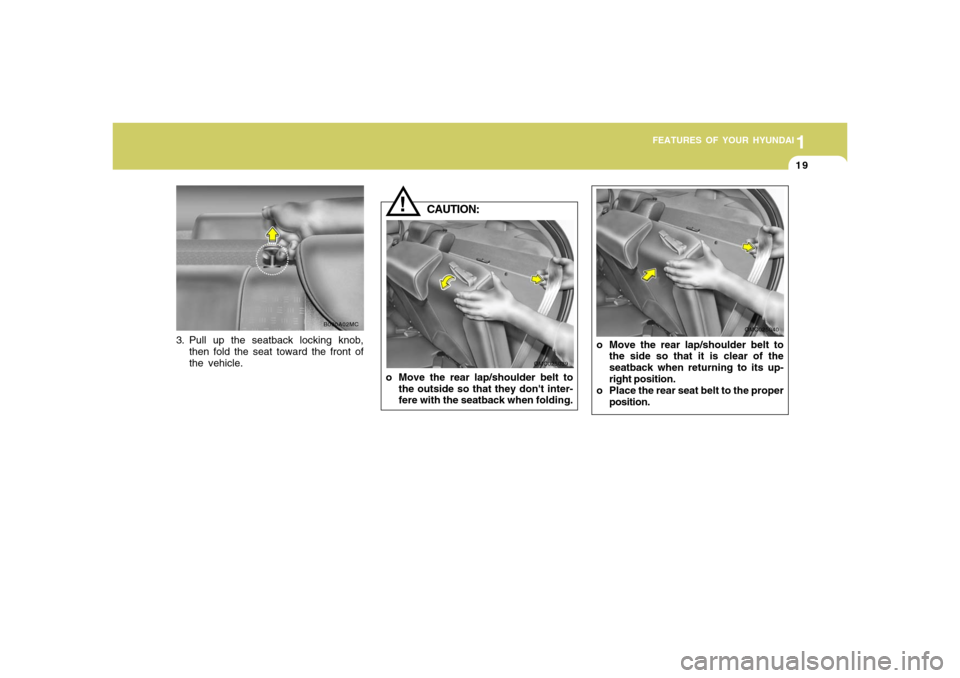
1
FEATURES OF YOUR HYUNDAI
191
FEATURES OF YOUR HYUNDAI
19
B090A02MC
3. Pull up the seatback locking knob,
then fold the seat toward the front of
the vehicle.
!
CAUTION:
o Move the rear lap/shoulder belt to
the outside so that they don't inter-
fere with the seatback when folding.o Move the rear lap/shoulder belt to
the side so that it is clear of the
seatback when returning to its up-
right position.
o Place the rear seat belt to the proper
position.
OMC025040
OMC025039
Page 50 of 273
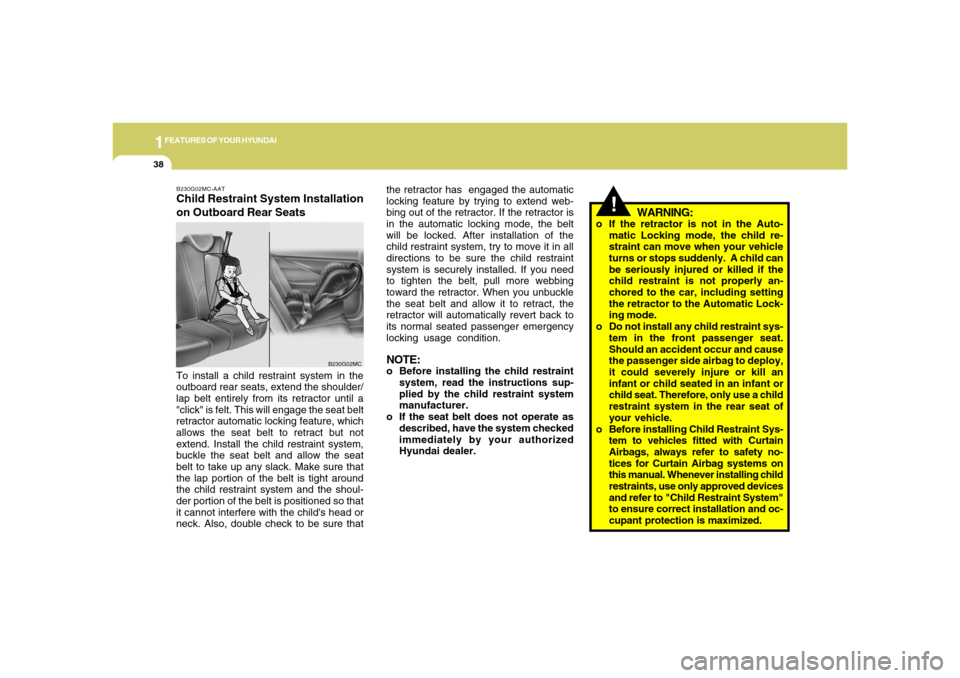
1FEATURES OF YOUR HYUNDAI38
!
WARNING:
o If the retractor is not in the Auto-
matic Locking mode, the child re-
straint can move when your vehicle
turns or stops suddenly. A child can
be seriously injured or killed if the
child restraint is not properly an-
chored to the car, including setting
the retractor to the Automatic Lock-
ing mode.
o Do not install any child restraint sys-
tem in the front passenger seat.
Should an accident occur and cause
the passenger side airbag to deploy,
it could severely injure or kill an
infant or child seated in an infant or
child seat. Therefore, only use a child
restraint system in the rear seat of
your vehicle.
o Before installing Child Restraint Sys-
tem to vehicles fitted with Curtain
Airbags, always refer to safety no-
tices for Curtain Airbag systems on
this manual. Whenever installing child
restraints, use only approved devices
and refer to "Child Restraint System"
to ensure correct installation and oc-
cupant protection is maximized. the retractor has engaged the automatic
locking feature by trying to extend web-
bing out of the retractor. If the retractor is
in the automatic locking mode, the belt
will be locked. After installation of the
child restraint system, try to move it in all
directions to be sure the child restraint
system is securely installed. If you need
to tighten the belt, pull more webbing
toward the retractor. When you unbuckle
the seat belt and allow it to retract, the
retractor will automatically revert back to
its normal seated passenger emergency
locking usage condition.
NOTE:o Before installing the child restraint
system, read the instructions sup-
plied by the child restraint system
manufacturer.
o If the seat belt does not operate as
described, have the system checked
immediately by your authorized
Hyundai dealer.
To install a child restraint system in the
outboard rear seats, extend the shoulder/
lap belt entirely from its retractor until a
"click" is felt. This will engage the seat belt
retractor automatic locking feature, which
allows the seat belt to retract but not
extend. Install the child restraint system,
buckle the seat belt and allow the seat
belt to take up any slack. Make sure that
the lap portion of the belt is tight around
the child restraint system and the shoul-
der portion of the belt is positioned so that
it cannot interfere with the child's head or
neck. Also, double check to be sure thatB230G02MC-AATChild Restraint System Installation
on Outboard Rear Seats
B230G02MC
Page 63 of 273
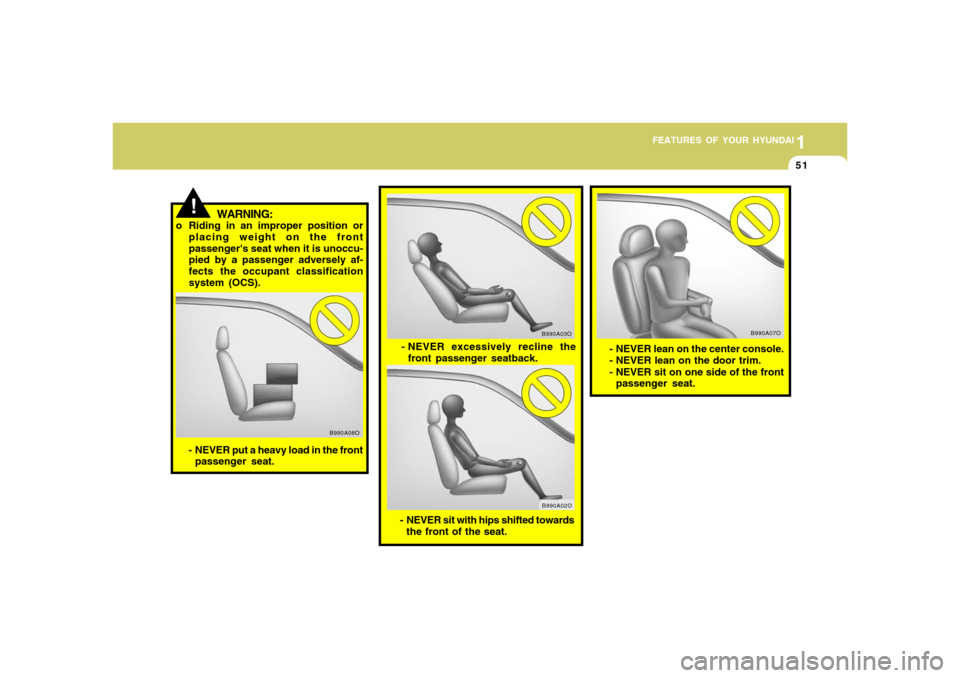
1
FEATURES OF YOUR HYUNDAI
511
FEATURES OF YOUR HYUNDAI
51
- NEVER put a heavy load in the front
passenger seat.
B990A08O
!
WARNING:
o Riding in an improper position or
placing weight on the front
passenger's seat when it is unoccu-
pied by a passenger adversely af-
fects the occupant classification
system (OCS).
- NEVER lean on the center console.
- NEVER lean on the door trim.
- NEVER sit on one side of the front
passenger seat.
B990A07O
- NEVER excessively recline the
front passenger seatback.
- NEVER sit with hips shifted towards
the front of the seat.
B990A03O
B990A02O
Page 70 of 273
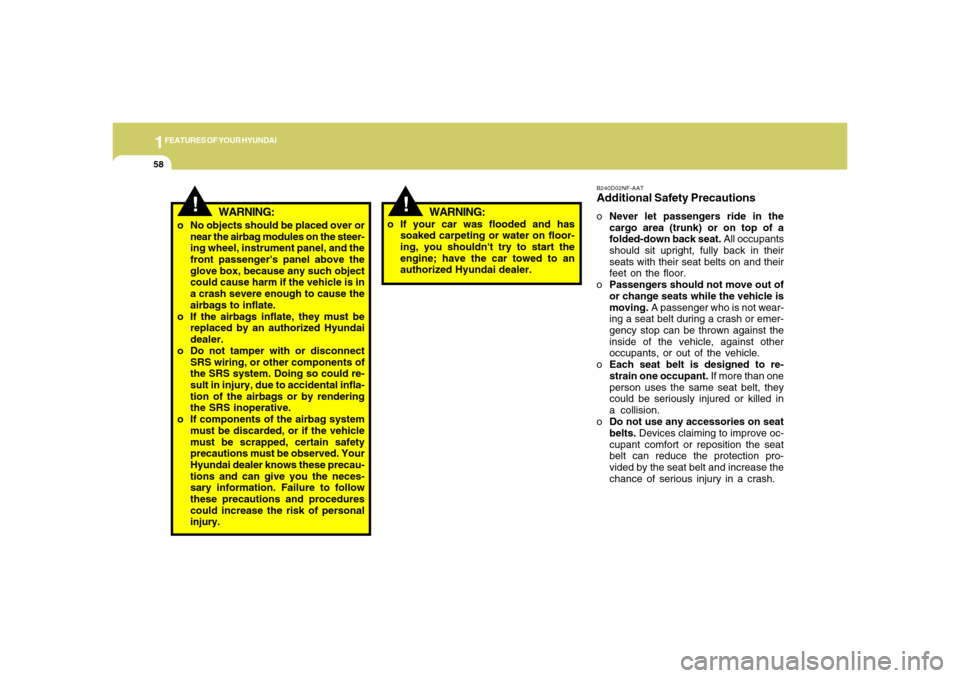
1FEATURES OF YOUR HYUNDAI58
B240D02NF-AATAdditional Safety PrecautionsoNever let passengers ride in the
cargo area (trunk) or on top of a
folded-down back seat. All occupants
should sit upright, fully back in their
seats with their seat belts on and their
feet on the floor.
oPassengers should not move out of
or change seats while the vehicle is
moving. A passenger who is not wear-
ing a seat belt during a crash or emer-
gency stop can be thrown against the
inside of the vehicle, against other
occupants, or out of the vehicle.
oEach seat belt is designed to re-
strain one occupant. If more than one
person uses the same seat belt, they
could be seriously injured or killed in
a collision.
oDo not use any accessories on seat
belts. Devices claiming to improve oc-
cupant comfort or reposition the seat
belt can reduce the protection pro-
vided by the seat belt and increase the
chance of serious injury in a crash.
!
WARNING:
o No objects should be placed over or
near the airbag modules on the steer-
ing wheel, instrument panel, and the
front passenger's panel above the
glove box, because any such object
could cause harm if the vehicle is in
a crash severe enough to cause the
airbags to inflate.
o If the airbags inflate, they must be
replaced by an authorized Hyundai
dealer.
o Do not tamper with or disconnect
SRS wiring, or other components of
the SRS system. Doing so could re-
sult in injury, due to accidental infla-
tion of the airbags or by rendering
the SRS inoperative.
o If components of the airbag system
must be discarded, or if the vehicle
must be scrapped, certain safety
precautions must be observed. Your
Hyundai dealer knows these precau-
tions and can give you the neces-
sary information. Failure to follow
these precautions and procedures
could increase the risk of personal
injury.
!
WARNING:
o If your car was flooded and has
soaked carpeting or water on floor-
ing, you shouldn't try to start the
engine; have the car towed to an
authorized Hyundai dealer.
Page 77 of 273
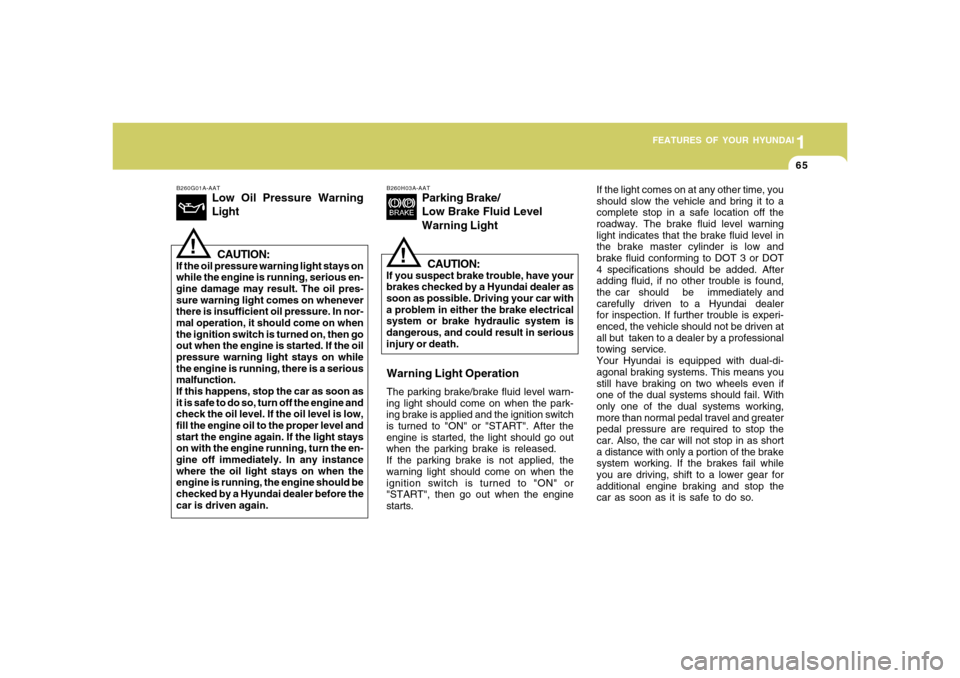
1
FEATURES OF YOUR HYUNDAI
651
FEATURES OF YOUR HYUNDAI
65
B260G01A-AAT
Low Oil Pressure Warning
LightCAUTION:
If the oil pressure warning light stays on
while the engine is running, serious en-
gine damage may result. The oil pres-
sure warning light comes on whenever
there is insufficient oil pressure. In nor-
mal operation, it should come on when
the ignition switch is turned on, then go
out when the engine is started. If the oil
pressure warning light stays on while
the engine is running, there is a serious
malfunction.
If this happens, stop the car as soon as
it is safe to do so, turn off the engine and
check the oil level. If the oil level is low,
fill the engine oil to the proper level and
start the engine again. If the light stays
on with the engine running, turn the en-
gine off immediately. In any instance
where the oil light stays on when the
engine is running, the engine should be
checked by a Hyundai dealer before the
car is driven again.
!
B260H03A-AAT
Parking Brake/
Low Brake Fluid Level
Warning Light
CAUTION:
If you suspect brake trouble, have your
brakes checked by a Hyundai dealer as
soon as possible. Driving your car with
a problem in either the brake electrical
system or brake hydraulic system is
dangerous, and could result in serious
injury or death.Warning Light OperationThe parking brake/brake fluid level warn-
ing light should come on when the park-
ing brake is applied and the ignition switch
is turned to "ON" or "START". After the
engine is started, the light should go out
when the parking brake is released.
If the parking brake is not applied, the
warning light should come on when the
ignition switch is turned to "ON" or
"START", then go out when the engine
starts.
!
If the light comes on at any other time, you
should slow the vehicle and bring it to a
complete stop in a safe location off the
roadway. The brake fluid level warning
light indicates that the brake fluid level in
the brake master cylinder is low and
brake fluid conforming to DOT 3 or DOT
4 specifications should be added. After
adding fluid, if no other trouble is found,
the car should be immediately and
carefully driven to a Hyundai dealer
for inspection. If further trouble is experi-
enced, the vehicle should not be driven at
all but taken to a dealer by a professional
towing service.
Your Hyundai is equipped with dual-di-
agonal braking systems. This means you
still have braking on two wheels even if
one of the dual systems should fail. With
only one of the dual systems working,
more than normal pedal travel and greater
pedal pressure are required to stop the
car. Also, the car will not stop in as short
a distance with only a portion of the brake
system working. If the brakes fail while
you are driving, shift to a lower gear for
additional engine braking and stop the
car as soon as it is safe to do so.
Page 89 of 273
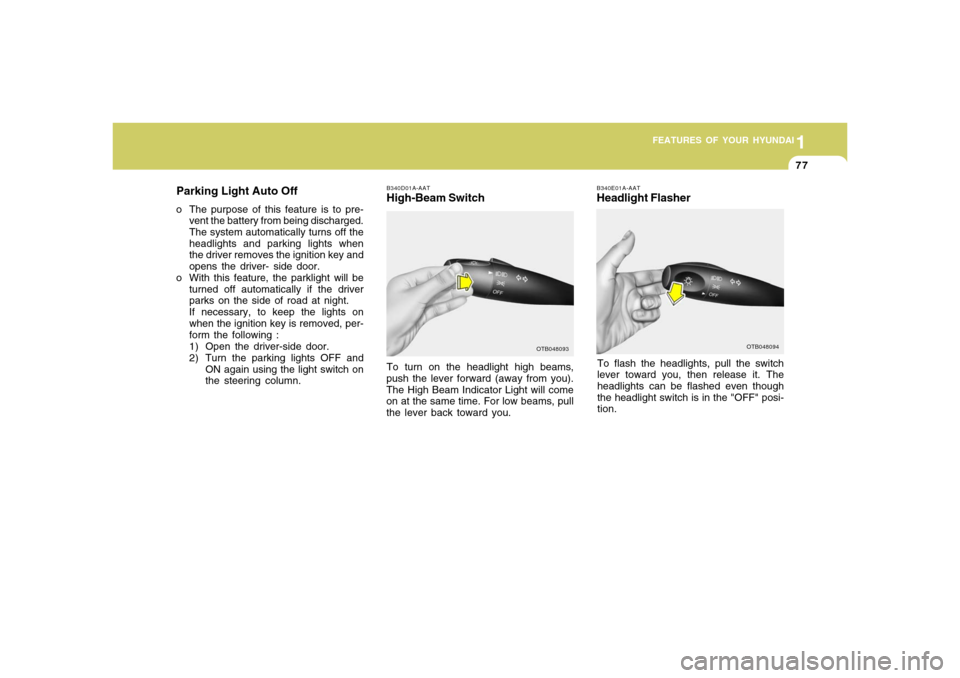
1
FEATURES OF YOUR HYUNDAI
771
FEATURES OF YOUR HYUNDAI
77
B340E01A-AATHeadlight FlasherTo flash the headlights, pull the switch
lever toward you, then release it. The
headlights can be flashed even though
the headlight switch is in the "OFF" posi-
tion.
B340D01A-AATHigh-Beam Switch
OTB048094
Parking Light Auto Offo The purpose of this feature is to pre-
vent the battery from being discharged.
The system automatically turns off the
headlights and parking lights when
the driver removes the ignition key and
opens the driver- side door.
o With this feature, the parklight will be
turned off automatically if the driver
parks on the side of road at night.
If necessary, to keep the lights on
when the ignition key is removed, per-
form the following :
1) Open the driver-side door.
2) Turn the parking lights OFF and
ON again using the light switch on
the steering column.To turn on the headlight high beams,
push the lever forward (away from you).
The High Beam Indicator Light will come
on at the same time. For low beams, pull
the lever back toward you.
OTB048093